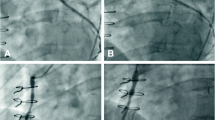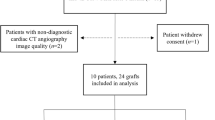Abstract
Coronary artery bypass graft (CABG) failure has been linked to graft hemodynamics, in particular wall shear stress. This study characterizes the morphology, geometry and wall shear stress patterns in human CABGs. The intimal thickness (IT) in 49 human saphenous vein CABGs was measured by digital light microscopy. The geometry of six saphenous vein CABGs was replicated by post-mortem infusion of Batson’s #17 anatomical corrosion casting compound. Graft hemodynamics were evaluated in two flow models, fabricated from the casts, under steady (Re = 110) and pulsatile flow (Re = 110, α = 2) conditions. Saphenous vein CABGs in situ for more than 2 months had, on average, the greatest IT on the hood and suture sites of the distal anastomosis. Floor thickening was highly variable and significantly less than IT at the hood, suture site and graft body. All casts showed an indentation along the floor and 5/6 casts displayed a sharp local curvature on the hood. In both flow models, a large increase in wall shear rate occurred on the hood, just proximal to the toe. The local geometry of the hood created this large spatial gradient in wall shear stress which is a likely factor in hood intimal hyperplasia.
Similar content being viewed by others
References
Abizaid, A., M. A. Costa, M. Centemero, A. S. Abizaid, V. M. Legrand, R. V. Limet, G. Schuler, F. W. Mohr, W. Lindeboom, A. G. Sousa, J. E. Sousa, B. van Hout, P. G. Hugenholtz, F. Unger, and P. W. Serruys. Clinical and economic impact of diabetes mellitus on percutaneous and surgical treatment of multivessel coronary disease patients: Insights from the arterial revascularization therapy study (ARTS) trial. Circulation 104:533–538, 2001.
American Heart Association. Heart disease and stroke statistics-2003 update. 2002. Dallas Texas, American Heart Association.
Ballyk, P. D., C. Walsh, J. Butany, and M. Ojha. Compliance mismatch may promote graft-artery intimal hyperplasia by altering suture-line stresses. J. Biomech. 31:229–237, 1998.
Bassiouny, H. S., S. White, S. Glagov, E. Choi, D. P. Giddens, and C. K. Zarins. Anastomotic intimal hyperplasia: Mechanical injury or flow induced. J. Vasc. Surg. 15:708–716, 1992.
Berguer, R., R. F. Higgens, and D. J. Reddy: Intimal Hyperplasia; An experimental study. Arch Surg 115:332–335, 1980.
Bush, H. L. J., J. A. Jakubowski, G. R. Curl, D. Deykin, and D. C. Nabseth. The natural history of endothelial structure and function in arterialized vein grafts. J. Vasc. Surg. 3:204–215, 1986.
Butany, J. W., T. E. David, and M. Ojha. Histological and morphometric analyses of early and late aortocoronary vein grafts and distal anastomoses. Can. J. Cardiol. 14:671–677, 1998.
Couch, G. G., K. W. Johnston, and M. Ojha. Full-field flow visualization and velocity measurement with a photochromic grid method. Meas. Sci. Technol. 7:1238–1246, 1996.
de Feyter, P. J., P. W. Serruys, F. Unger, R. Beyar, de V. V. S. Milo, R. Simon, D. Regensburger, P. A. Crean, E. McGovern, van den HP, C. van Cauwelaert, I. Penn, G. F. Tyers, and W. Lindeboom. Bypass surgery versus stenting for the treatment of multivessel disease in patients with unstable angina compared with stable angina. Circ. 105:2367–2372, 2002.
DePaola, N., M. A. Gimbrone, P. F. Davies, and C. F. Dewey. Vascular endothelium responds to fluid shear stress gradients. Arterioscler. Thromb. 12:1254–1257, 1992.
Dobrin, P. B., R. Mirande, S. Kang, Q. S. Dong, and R. Mrkvicka. Mechanics of end-to-end artery-to-PTFE graft anastomoses. Ann. Vasc. Surg. 12:317–323, 1998.
Ethier, C. R., S. Prakash, D. A. Steinman, R. L. Leask, G. G. Couch, and M. Ojha. Steady flow separation patterns in a 45 degree junction. J. Fluid Mech. 411:1–38, 2000.
Ethier, C. R., D. A. Steinman, X. Zhang, S. R. Karpik, and M. Ojha. Flow waveform effects on end-to-side anastomotic flow patterns. J. Biomech. 31:609–617, 1998.
Fitzgibbon, G. M., J. R. Burton, and A. J. Leach. Coronary bypass graft fate; Angiographic grading of 1400 consecutive grafts early after operatin and of 1132 after one year. Circulation 57:1070–1074, 1978.
Fitzgibbon, G. M., H. P. Kafka, A. J. Leach, W. J. Keon, G. D. Hooper, and J. R. Burton. Coronary bypass graft fate and patient outcome; Angiographic follow up of 5,065 grafts related to survival and reoperation in 1388 patients during 25 years. J Am Coll Cardiol 28:616–626, 1996.
Fitzgibbon, G. M., A. J. Leach, W. J. Keon, J. R. Burton, and H. P. Kafka. Coronary bypass graft fate: Angiographic study of 1179 vein grafts early, one year, and five years after operation. J. Thorac. Cardiovasc. Surg. 91:773–778, 1986.
Fry, D. L. Acute vascular endothelial changes associated with increased blood velocity gradients. Circ. Res. 22:165–197, 1968.
Galjee, M. A., A. C. van Rossum, T. Doesburg, M. Hofman, T. Falke, and C. Visser. Quantification of coronary artery bypass graft flow by magnetic resonance phase velocity mapping. Magn. Reson. Imag. 14:485–493, 1996.
Garvey, W. Modified elastic tissue-Masson trichrome stain. Stain Technol. 59:213–216, 1984.
Garvey, W., A. Fathi, F. Bigelow, B. Carpenter, and C. Jimenez. A combined elastic, fibrin and collagen stain. Stain Technol. 62:365–368, 1987.
Ghali, W. A., H. Quan, and R. Brant. Coronary artery bypass grafting in Canada: National and provincial mortality trends, 1992–1995. CMAJ 159:25–31, 1998.
Giddens, D. P., C. K. Zarins, and S. Glagov. The role of fluid mechanics in the localization and detection of atherosclerosis. J. Biomech. Eng. 115:588–594, 1993.
Gimbrone, M. A., J. N. Topper, T. Nagel, K. R. Anderson, and G. Garcia-Cardena. Endothelial dysfunction, hemodynamic forces, and atherogenesis. Ann. N Y Acad. Sci. 902:230–239, 2000.
Graham, M. M., W. A. Ghali, P. D. Faris, P. D. Galbraith, C. M. Norris, and M. L. Knudtson. Survival after coronary revascularization in the elderly. Circ. 105:2378–2384, 2002.
Hasson, J. E., J. Megerman, and W. M. Abbott. Increased compliance near vascular anastomoses. J. Vasc. Surg. 2:419–423, 1985.
Inzoli, F., F. Migliavacca, and G. Pennati. Numerical analysis of steady flow in aorto-coronary bypass 3-D model. J. Biomech. Eng. 118:172–179, 1996.
Jackson, Z. S., H. Ishibashi, A. I. Gotlieb, and B. L. Langille. Effects of anastomotic angle on vascular tissue response at end-toside arterial grafts. J. Vasc. Surg. 34:300–307, 2001.
Jones, S. A., D. P. Giddens, F. Loth, C. K. Zarins, F. Kajiya, I. Morita, O. Hiramatsu, Y. Ogasawara, and K. Tsujioka. In-Vivo measurements of blood flow velocity profiles in canine ilio-femoral anastomotic bypass grafts. J. Biomech. Eng. 119:30–38, 1997.
Keynton, R. S., M. M. Evancho, R. L. Sims, and S. E. Rittgers. The effect of graft caliber upon wall shear within in vivo distal vascular anastomoses. J. Biomech. Eng. 121:79–88, 1999.
Keynton, R. S., M. M. Evancho, R. L. Sims, N. V. Rodway, A. Gobin, and S. E. Rittgers. Intimal hyperplasia and wall shear in arterial bypass graft distal anastomoses: An in vivo model study. J. Biomech. Eng. 123:464–473, 2001.
Lametschwandtner, A., U. Lametschwandtner, and T. Weiger. Scanning electron microscopy of vascular corronsion casts-technique and applications: Udated review. Scan. Microsc. 4:889–941, 1990.
Loth, F., S. A. Jones, D. P. Giddens, H. S. Bassiouny, S. Glagov, and C. K. Zarins. Measurements of velocity and wall shear stress inside a PTFE vascular graft model under steady flow conditions. J. Biomech. Eng. 119:187–194, 1997.
Moore, J. A., D. A. Steinman, S. Prakash, K. W. Johnston, and C. R. Ethier. A numerical study of blood flow patterns in anatomically realistic and simplified end-to-side anastomoses. J. Biomech. Eng. 121:265–272, 1999.
Nagel, T., N. Resnick, C. F. Dewey, and M. A. J. Gimbrone. Vascular Endothelial cell respond to spatial gradient in gluid shear stress by enhanced activation of transcription factors. Arterioscler. Thromb. Vasc. Biol. 19:1825–1834, 1999.
Nerem, R. M., R. W. Alexander, D. C. Chappell, R. M. Medford, S. E. Varner, and W. R. Taylor. The study of the influence of flow on vascular endothelial biology. Am. J. Med. Sci. 316:169–175, 1998.
Office for official publications of the european communities: Health statistics Atlas on mortality in the European Union: Chapter 8 Cardiovascular diseases. Offic. Publ. Eur. Commun. 1–9, 2003.
Ojha, M. Wall shear stress temporal gradient and anastomotic intimal hyperplasia. Circ. Res. 74:1227–1231, 1994.
Ojha, M., R. S. Cobbold, and K. W. Johnston. Hemodynamics of a side-to-end proximal arterial anastomosis model. J. Vasc. Surg. 17:646–655, 1993.
Ojha, M., R. S. Cobbold, and K. W. Johnston. Influence of angle on wall shear stress distribution for an end-to-side anastomosis. J. Vasc. Surg. 19:1067–1073, 1994.
Ojha, M., R. L. Hummel, R. S. Cobbold, and K. W. Johnston: Development and evaluation of a high resolution photochromic dye method for pulsatile flow studies. J. Phys. E: Sci. Instrum. 21:998–1004, 1988.
Ojha, M., R. L. Leask, K. W. Johnston, T. E. David, and J. Butany. Histology and morphology of 59 internal thoracic artery grafts and their distal anastomoses. Ann. Thorac. Cardiovasc. Surg. 70:1338–1344, 2000.
Park, H., J. A. Moore, O. Trass, and M. Ojha. Laser photochromic velocimetry estimation of the vorticity and pressure field-two dimenstional flow in a curved vessel. Exp. Fluids 26:55–62, 1999.
Popovich, A. T., and R. L. Hummel. A new method for non-disturbing turbulent flow measurements very close to a wall. Chem. Eng. Sci. 22:21–25, 1967.
Rittgers, S. E, P. E. Karayannacos, J. F. Guy, R. M. Nerem, G. M. Shaw, J. R. Hostetler, and J. S. Vasko: Velocity distribution and intimal proliferation in autologous vein grafts in dogs. Circ. Res. 42:792–801, 1978.
Smith, S. H., and J. C. Geer. Morphology of saphenous vein-coronary artery bypass grafts. Arch. Pathol. Lab. Med. 107:13–18, 1983.
Sottiurai, V. S., J. S. Yao, W. R. Flinn, and R. C. Batson. Intimal hyperplasia and neointima: An ultrastructural analysis of thrombosed grafts in humans. Surgery 93:809–817, 1983.
Steinman, D. A., and C. R. Ethier: The effect of wall distensibility on flow in a two-dimensional end-to-side anastomosis. J. Biomech. Eng. 116:294–301, 1994.
Tardy, Y., N. Resnick, T. Nagel, M. A. Gimbrone, and C. F. Dewey. Shear stress gradients remodel endothelial monolayers in vitro via a cell proliferation-midgration loss cycle. Arterioscler. Thromb. Vasc. Biol. 17:3102–3106, 2001.
Tiwari, A., K. S. Cheng, H. Salacinski, G. Hamilton, and A. M. Seifalian: Improving the patency of vascular bypass grafts: The role of suture materials and surgical techniques on reducing anastomotic compliance mismatch. Eur. J. Vasc. Endovasc. Surg. 25:287–295, 2003.
White, S., C. K. Zarins, D. P. Giddens, H. S. Bassiouny, S. A. Jones, and S. Glagov. Hemodynamic patterns in two models of end-to-side vascular graft anastomoses: Effects of pulsatility, flow division, reynolds number, and hood length. J. Biomech. Eng. 115:104–111, 1993.
Zeng, D., Z. Ding, M. H. Friedman, and C. R. Ethier. Effects of cardiac motion on right coronary artery hemodynamics. Ann. Biomed. Eng. 31:420–429, 2003.
Author information
Authors and Affiliations
Corresponding author
Rights and permissions
About this article
Cite this article
Leask, R.L., Butany, J., Johnston, K.W. et al. Human Saphenous Vein Coronary Artery Bypass Graft Morphology, Geometry and Hemodynamics. Ann Biomed Eng 33, 301–309 (2005). https://doi.org/10.1007/s10439-005-1732-z
Received:
Accepted:
Issue Date:
DOI: https://doi.org/10.1007/s10439-005-1732-z




